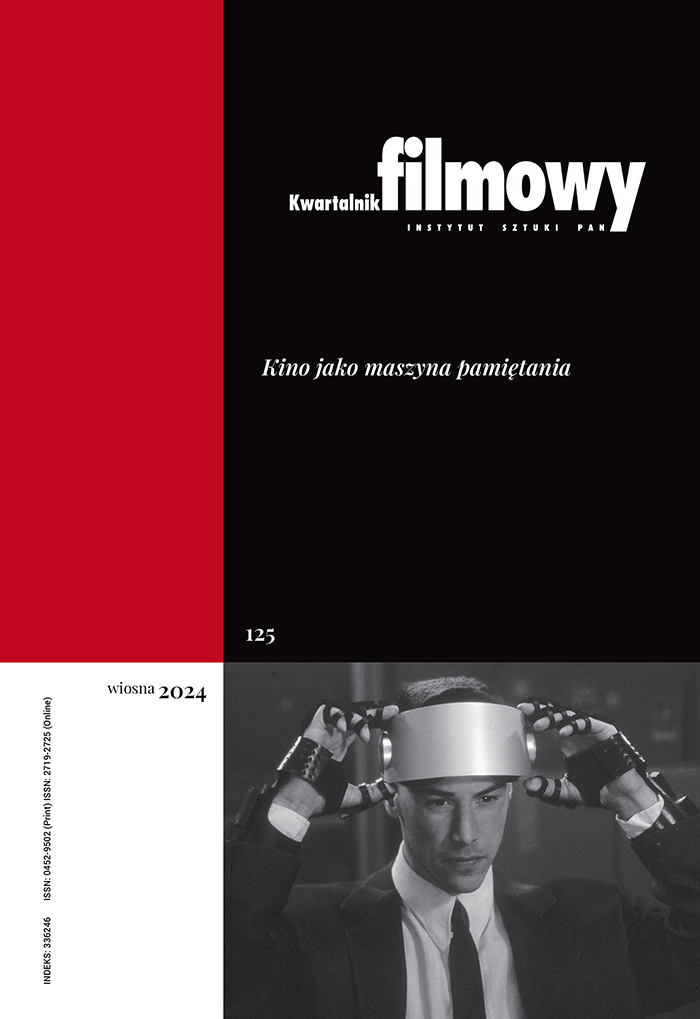Pantomime and Film: A Different Perspective
Abstract
This article is born out of the author's fascination with the golden era of cinema, and his admiration for everything that resulted in fantastic achievements in pantomime and film. The author seeks to answer the question: what does cinema gain from the art of pantomime? He outlines the history of cinematographic pantomime, the relationship between the two arts and above all he notes the interest with which this relationship has been analyzed by researchers specializing in the beginnings of cinema. Hendryko- wski believes that gesture as a means of expression was bypassed by previous researchers analyzing the development of film. Traditional histories of the cinema tend to be “logocentric”, which approach was to give film the status of an art. This also meant that gestures were bypassed in the analysis and presentation. However the author also presents the work of people, who did not fully accept this logocentric approach (e.g. Irzykowski, Mukarovsky). Hendrykowski considers the following perspectives in his analysis of the relationship between film and pantomime in the golden era of cinema: 1) sociological, 2) perspective of communication, 3) semiotic, 4) artistic, 5) anthropological, 6) aesthetic, 7) the perspective of history of film.
Keywords:
pantomime, Karol Irzykowski, Jan MukařovskýReferences
Agee James, Comedy Greatest Era, “Life”, 5 Sept. 1949, s. 74-75.
Google Scholar
Balcerzan Edward, Estetyka: czwarta gałąź semiotyki, w: E. Balcerzan, Kręgi wtajemniczenia. Czytelnik. Badacz. Tłumacz. Pisarz, Kraków 1982, s. 124-135.
Google Scholar
Irzykowski Karol, Dziesiąta muza. Zagadnienia estetyczne kina, Kraków 1924.
Google Scholar
Irzykowski Karol, X muza, Warszawa 1984, s. 203, 229.
Google Scholar
Méliès Georges, Les vues cinématographiques, «Annuaire général et international de la Photographie», Paris 1907.
Google Scholar
Méliès Georges, Rozmaite rodzaje obrazów kinematograficznych, tłum. I. Dembowski, „Kultura Filmowa”, 1970, nr 12.
Google Scholar
Mukařovský Jan, Próba strukturalnej analizy fenomenu aktorstwa (Chaplin w „Światłach wielkiego miasta”), tłum. J. Mayen w: J. Mukařovský, Wśród znaków i struktur. Wybór szkiców, wyb., red. i słowo wstępne J. Sławiński, Warszawa 1970, s. 390-391.
Google Scholar
Słonimski Antoni, Romans z Dziesiątą Muzą. Teksty filmowe z lat 1917-1976, Wstęp i red. naukowa M. Hendrykowska, M. Hendrykowski, Warszawa 2007.
Google Scholar
Authors
Marek Hendrykowskikwartalnik.filmowy@ispan.pl
Adam Mickiewicz University, Poznań Poland
Historyk i teoretyk filmu, założyciel poznańskiego filmoznawstwa, wykłada na Uniwersytecie im. Adama Mickiewicza w Poznaniu. Autor książek m.in. Słowo w filmie. Historia-teoria-interpretacja (1982), Historia filmowego Oscara (1988, 1993), Autor jako problem poetyki filmu (1988), Słownik terminów filmowych (1994), Stanisław Różewicz (1997), Sztuka krótkiego metrażu (1998), Jezyk ruchomych obrazów (1999), Film jako źródło historyczne (2000), Leksykon gatunków filmowych (2001), Nóż w wodzie (2005), Rejs (2005), Andrzej Munk (2007), Popiół i diament (2008), Marcel Łoziński (2008), Komeda (2009). Ekspert Polskiego Instytutu Sztuki Filmowej. Od roku 2007 stały współpracownik TVP Kultura.
Statistics
Abstract views: 547PDF downloads: 148
License
Copyright (c) 2009 Marek Hendrykowski

This work is licensed under a Creative Commons Attribution 4.0 International License.
The author grants the publisher a royalty-free non-exclusive licence (CC BY 4.0) to use the article in Kwartalnik Filmowy, retains full copyright, and agrees to identify the work as first having been published in Kwartalnik Filmowy should it be published or used again (download licence agreement). The journal is published under the CC BY 4.0 licence. By submitting an article, the author agrees to make it available under this licence.
In issues from 105-106 (2019) to 119 (2022) all articles were published under the CC BY-NC-ND 4.0 licence. During this period the authors granted a royalty-free non-exclusive licence (CC BY-ND 4.0) to use their article in „Kwartalnik Filmowy”, retained full copyright, and agreed to identify the work as first having been published in our journal should it be published or used again.
Most read articles by the same author(s)
- Marek Hendrykowski, Cinema and Theatre – Cultural Collision of the Media (1895-1914) , Kwartalnik Filmowy: No. 87-88 (2014): Film and Theatre
- Marek Hendrykowski, Fractal Time: On Evolution of the Notions of Time in Contemporary Cinema , Kwartalnik Filmowy: No. 86 (2014): Dimensions of Time
- Marek Hendrykowski, Taking Off to the Other Side of Atlantic: The American Debut of Miloš Forman , Kwartalnik Filmowy: No. 93-94 (2016): American Cinema
- Marek Hendrykowski, About the Narration of “Eroica”: New Technique – New Language , Kwartalnik Filmowy: No. 71-72 (2010): Narration in Film
- Marek Hendrykowski, The Metaphysics in “The Labyrinth” by Jan Lenica , Kwartalnik Filmowy: No. 96 (2016): Film and Metaphysics
- Marek Hendrykowski, How the Polish Film School Was Terminated , Kwartalnik Filmowy: No. 103 (2018): Young Polish Cinema – Confrontation of Generations
- Marek Hendrykowski, Sound on the Screen: Sound Breakthrough in Cinema , Kwartalnik Filmowy: No. 44 (2003): Sound, Music, Word in Film
- Marek Hendrykowski, Can Leni Riefenstahl Be Forgiven? , Kwartalnik Filmowy: No. 89-90 (2015): Redefinitions of the Classics
- Marek Hendrykowski, Song in the Polish Film of the Socialist Era , Kwartalnik Filmowy: No. 91 (2015): Film Between Pop Music and Pop Culture
- Marek Hendrykowski, The Child Runs Deep in Albert: Study on Albert Lamorisse’s “The Red Balloon” , Kwartalnik Filmowy: No. 81 (2013): Child in Film











